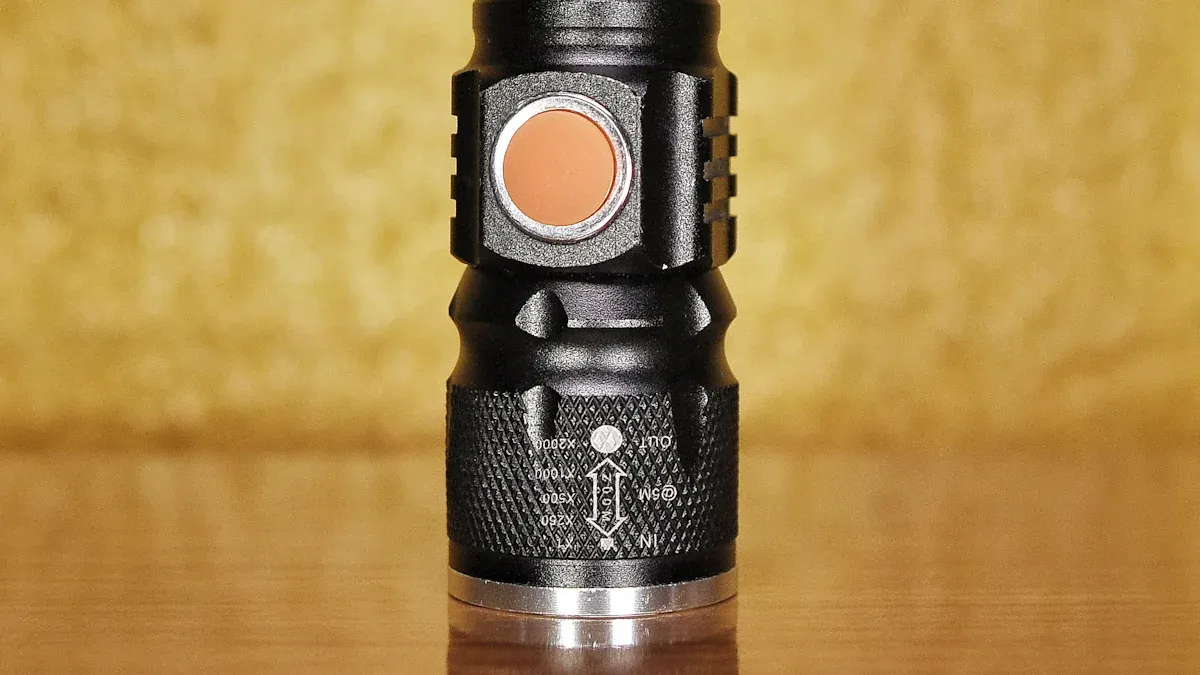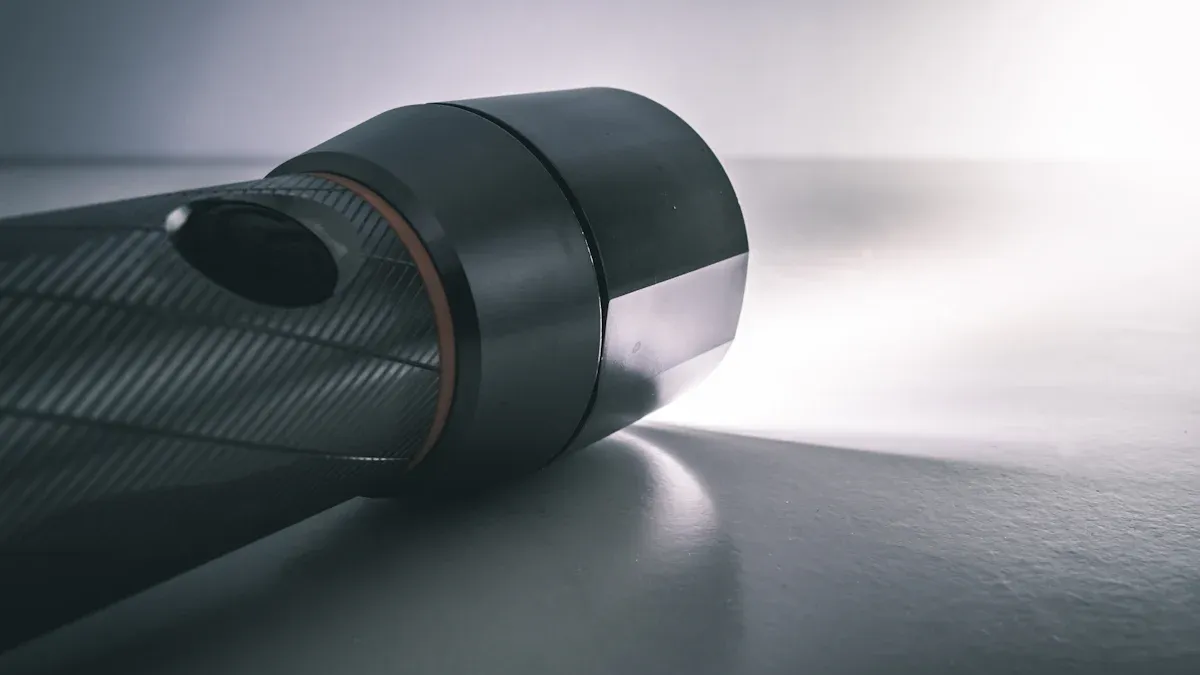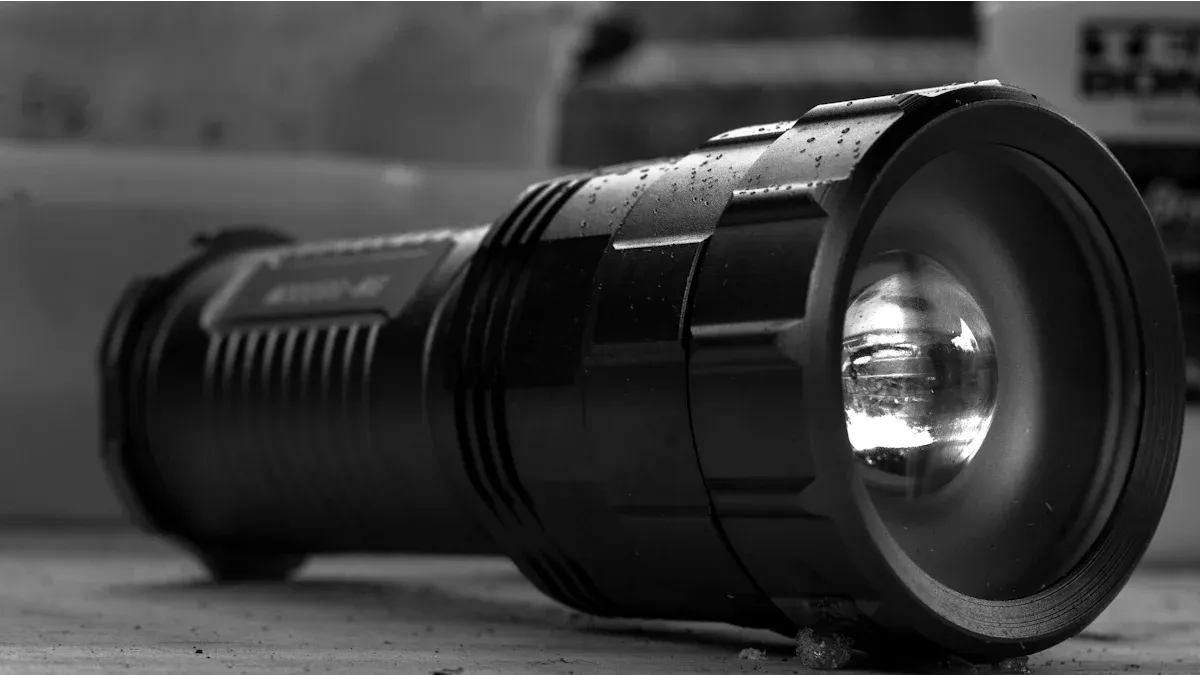The Role of Flashlights in Preparing for Natural Disasters and Emergencies

Emergencies often strike without warning, leaving you in the dark—literally. A flashlight becomes your lifeline, offering safety and visibility. During Hurricane Katrina, a family used their flashlight to signal rescuers, saving their lives. Whether navigating hazards or signaling for help, tools like the helius flashlight are vital for emergency preparedness.
Key Takeaways
Flashlights are important during blackouts. They help you see and stay safe.
Pick a good flashlight for emergencies. Options include battery, solar, or hand-crank types.
Check your flashlight often to make sure it works. Test it and keep it in an easy-to-find spot.
Why Flashlights Are Essential in Emergency Preparedness

Reliability During Power Outages
Power outages often accompany natural disasters, leaving you in complete darkness. A flashlight becomes your primary source of light during these moments. It ensures visibility, helping you navigate safely through your home or surroundings. Flashlights also prevent accidents like tripping over obstacles or bumping into furniture. Additionally, they play a crucial role in emergency response efforts by illuminating areas where help is needed. Unlike other light sources, flashlights are portable and easy to use, making them indispensable in emergency preparedness.
Flashlights provide illumination during darkness.
They enhance safety by preventing accidents.
Flashlights facilitate emergency response efforts.
Enhancing Safety in Hazardous Conditions
Emergencies often create hazardous conditions that require immediate attention. Flashlights are essential tools in such scenarios. For example, during a fire or an accident, a high-quality flashlight with advanced LED technology can light up the scene, ensuring safety for everyone involved. In low-light environments like basements or outdoor areas during storms, flashlights help you identify potential dangers. They also assist in search and rescue operations, providing bright and reliable light to guide you through repairs or inspections.
A Safer Alternative to Candles
Candles may seem like a quick solution during a power outage, but they come with significant risks. Open flames can easily cause fires, especially in chaotic situations. Flashlights offer a much safer alternative. They provide consistent light without the danger of starting a fire. Modern flashlights are designed to last longer and are more reliable than candles. By including a flashlight in your emergency kit, you reduce the risk of accidents and ensure a dependable source of light during any disaster.
Choosing the Right Flashlight for Your Emergency Kit
Battery-Powered Flashlights
Battery-powered flashlights are a staple in emergency kits due to their convenience and reliability. They use widely available AA or AAA batteries, making replacements easy to find during a disaster. These flashlights are cost-effective and compatible with various devices, ensuring you have a dependable light source when needed. However, they may have limitations, such as lower power output and performance issues in extreme temperatures.
Advantages of AA Battery-Powered Flashlights | Disadvantages of AA Battery-Powered Flashlights |
|---|---|
Widespread availability of AA batteries | Lower power output compared to specialized batteries |
Cost-effective and affordable | Added weight and bulk |
Easy battery replacement | Limited advanced features |
Compatibility with various devices | Potential performance issues in extreme temperatures |
Solar-Powered Flashlights
Solar-powered flashlights harness sunlight to provide illumination, making them an eco-friendly choice for emergencies. These flashlights are ideal for long-term preparedness since they eliminate the need for disposable batteries. They work best in sunny conditions, so keeping them charged during daylight hours ensures they are ready for nighttime use. Their sustainability and independence from traditional power sources make them a valuable addition to your emergency kit.
Hand-Crank Flashlights
Hand-crank flashlights stand out for their reliability and durability. They operate without batteries, relying on manual energy to generate light. This feature ensures continuous illumination during emergencies, even when other power sources are unavailable. These flashlights also promote sustainability by reducing battery waste and environmental impact. Their robust construction allows them to withstand harsh conditions, making them a dependable option for disaster scenarios.
Durable and Waterproof Models
Durability is crucial when selecting a flashlight for emergencies. High-quality flashlights often feature materials like stainless steel, titanium, or anodized aluminum, which resist corrosion and withstand impacts. Waterproof models with sealed casings prevent water ingress, ensuring functionality during floods or heavy rain. These features guarantee that your flashlight remains operational in challenging environments, enhancing your safety and preparedness.
Material/Feature | Description |
|---|---|
Sealed Casings | High-quality flashlights have tightly sealed casings and components to prevent water ingress. |
Corrosion-Resistant Materials | Anodized aluminum and stainless steel resist rust and corrosion, enhancing durability. |
Rigorous Testing Standards | Flashlights undergo extensive testing to ensure they can withstand real-world conditions. |
The Helius Flashlight as a Reliable Option
The Helius flashlight combines compact size, durability, and advanced features, making it an excellent choice for emergencies. Its adjustable brightness settings allow you to adapt to different environments while conserving energy. The flashlight’s long battery life ensures extended runtime, reducing the need for frequent recharging. Additional safety features, such as SOS mode and strobe light, enhance its utility during critical situations. Users have praised its robust construction, which withstands harsh conditions, ensuring reliability when you need it most.
Preparing and Maintaining Flashlights for Emergencies
Storing Extra Batteries and Power Sources
Proper storage of batteries ensures your flashlight remains functional during emergencies. Keep batteries in a cool, dry place, away from direct sunlight or extreme temperatures. Humid environments can damage battery cells, so avoid storing them in areas prone to moisture. Use the original packaging or a battery case to prevent contact with metal objects that could cause short circuits. Never store loose batteries together, as they may discharge or leak when in contact with each other.
Check expiration dates regularly and dispose of expired batteries promptly. Mixing different battery types or combining old and new batteries in the same flashlight can reduce performance. If you notice leakage, handle the battery with gloves and dispose of it safely. For optimal performance, store batteries at room temperature (68°F to 78°F) with moderate humidity levels (35% to 65%).
Regular Functionality Checks
Routine checks ensure your flashlight works when you need it most. Test the flashlight every few months to confirm it powers on and provides adequate light. Inspect the batteries for signs of corrosion or leakage. Replace weak or expired batteries immediately. If your flashlight has multiple modes, cycle through them to verify functionality. Regular maintenance keeps your flashlight reliable during a disaster.
Strategic Placement for Easy Access
Strategic placement of flashlights enhances visibility and safety during emergencies. Keep one on your nightstand for quick access at night. Place flashlights near doors to guide you outside or check your surroundings. Store them in the garage or shed for outdoor emergencies. A flashlight in the kitchen is useful since it’s a central location in most homes. Always keep one in your car for roadside emergencies. These placements ensure you can quickly locate a flashlight when disaster strikes.
Long-Term Storage Tips
Long-term storage requires careful planning to maintain flashlight performance. Store your flashlight in a safe, secure location, away from extreme temperatures and direct sunlight. Remove the batteries if you plan to store it for an extended period to prevent leakage or corrosion. Keep the flashlight in a cool, dry place, and consider using a protective case or pouch for added safety. These steps ensure your flashlight remains functional and ready for use during emergencies.
Practical Uses of Flashlights During Emergencies

Navigating Safely in the Dark
A flashlight is your best tool for navigating safely during emergencies. It illuminates your path, helping you avoid obstacles like debris or uneven ground. This is especially important during blackouts or wildfires when visibility is low. Flashlights also allow you to evacuate quickly and safely.
Illuminate paths to avoid hazards.
Reveal obstacles like debris or uneven terrain.
Enable safe movement during blackouts or wildfires.
In 2023, a woman in Florida used her phone’s flashlight to signal rescuers. A helicopter spotted her light, leading to her rescue. This highlights the life-saving potential of light during emergencies.
Signaling for Help in Distress
Flashlights are essential for signaling rescuers during emergencies. Use bright, flashing lights instead of steady beams to attract attention. Practice the SOS signal pattern—three short flashes, three long flashes, and three short flashes. This globally recognized signal increases your chances of being noticed. Aim your flashlight at reflective surfaces to amplify visibility. Always ensure your flashlight is fully charged and ready for use.
Inspecting for Damages or Hazards
After a disaster, a flashlight helps you inspect for damages or hazards. It provides the light needed to assess injuries, examine structural damage, or identify potential threats. Flashlights are also vital for search and rescue operations. They enhance safety by illuminating dark areas and making your presence known.
Assess injuries and structural damage.
Identify hazards in dark environments.
Facilitate search and rescue efforts.
Providing Comfort and Security
Flashlights offer more than just light—they provide psychological comfort during emergencies. A reliable light source reduces anxiety and fear, helping you and your family feel secure. It maintains a sense of normalcy in stressful situations, making it an essential part of your disaster supplies kit.
Including a flashlight in your emergency kit is essential for safety and preparedness. Flashlights help you see in smoky rooms, signal for help, and ensure safety during evacuations. Choose durable, water-resistant models with reliable battery life. Regularly inspect your emergency supplies, including flashlights, batteries, and a battery-powered radio, to stay informed and ready. Store your flashlight in an accessible location alongside other essentials like first aid and CPR guides, a first aid kit, and a battery-powered radio. These steps ensure you can navigate emergencies with confidence, whether finding shelter or addressing immediate needs. Proactive preparation brings peace of mind and keeps you ready for any situation.
FAQ
How often should you check your flashlight for functionality?
You should test your flashlight every three months. This ensures it works properly during an emergency and allows you to replace batteries or address any issues.
What type of flashlight is best for flood-prone areas?
Choose a durable, waterproof flashlight. These models withstand water exposure and remain functional during floods or heavy rain, ensuring reliable light in challenging conditions.
Can a flashlight help during a medical emergency?
Yes, a flashlight can illuminate injuries, assist in first aid, and help you inspect wounds. It ensures you can provide care even in low-light situations.
See Also
Why Hunting Flashlights Are Crucial For Outdoor Adventures
A Homeowner's Guide To Selecting The Ideal Emergency Flashlight
Hand-Cranked Flashlights: Essential Portable Emergency Tools
How Rechargeable Flashlights Enhance Public Safety Measures
Camping Essentials: Comparing Lanterns And Flashlights For Illumination
